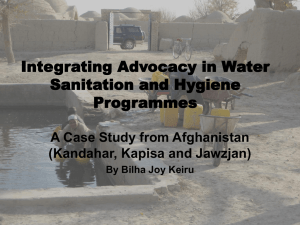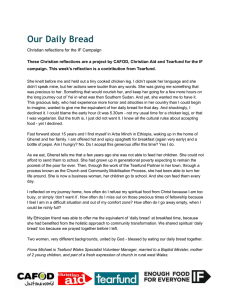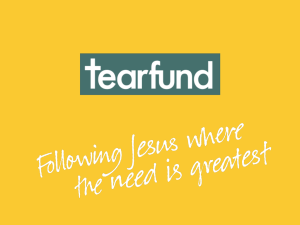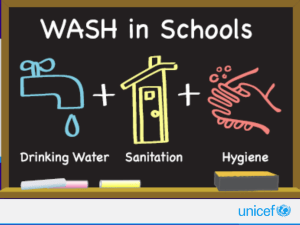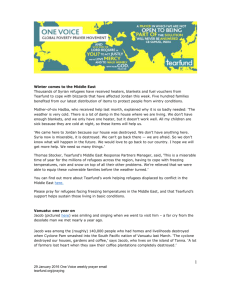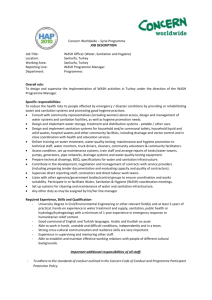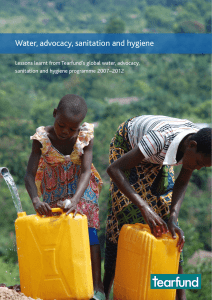WASH PART TWO OUR CONTRIBUTION TO CHANGE
advertisement
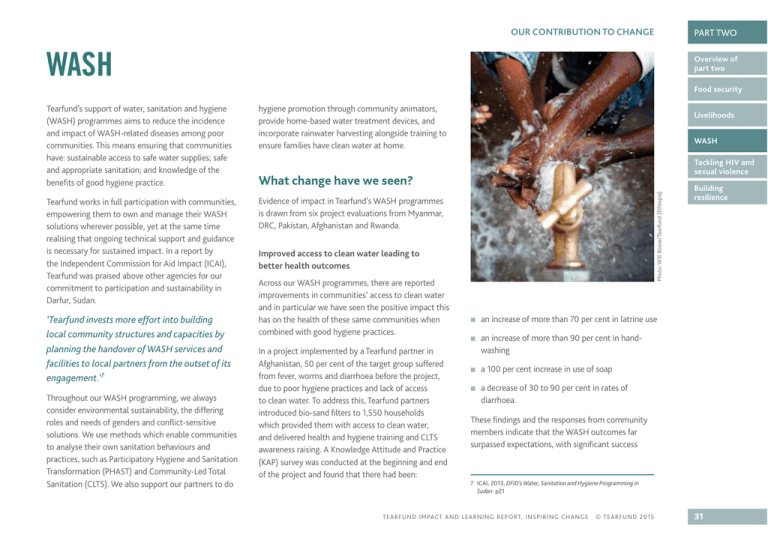
OUR CONTRIBUTION TO CHANGE PART TWO WASH Overview of part two Food security Tearfund works in full participation with communities, empowering them to own and manage their WASH solutions wherever possible, yet at the same time realising that ongoing technical support and guidance is necessary for sustained impact. In a report by the Independent Commission for Aid Impact (ICAI), Tearfund was praised above other agencies for our commitment to participation and sustainability in Darfur, Sudan. ‘Tearfund invests more effort into building local community structures and capacities by planning the handover of WASH services and facilities to local partners from the outset of its engagement.’7 Throughout our WASH programming, we always consider environmental sustainability, the differing roles and needs of genders and conflict-sensitive solutions. We use methods which enable communities to analyse their own sanitation behaviours and practices, such as Participatory Hygiene and Sanitation Transformation (PHAST) and Community-Led Total Sanitation (CLTS). We also support our partners to do hygiene promotion through community animators, provide home-based water treatment devices, and incorporate rainwater harvesting alongside training to ensure families have clean water at home. Livelihoods WASH Tackling HIV and sexual violence What change have we seen? Photo: Will Boase/Tearfund (Ethiopia) Tearfund’s support of water, sanitation and hygiene (WASH) programmes aims to reduce the incidence and impact of WASH-related diseases among poor communities. This means ensuring that communities have: sustainable access to safe water supplies; safe and appropriate sanitation; and knowledge of the benefits of good hygiene practice. Evidence of impact in Tearfund’s WASH programmes is drawn from six project evaluations from Myanmar, DRC, Pakistan, Afghanistan and Rwanda. Improved access to clean water leading to better health outcomes Across our WASH programmes, there are reported improvements in communities’ access to clean water and in particular we have seen the positive impact this has on the health of these same communities when combined with good hygiene practices. In a project implemented by a Tearfund partner in Afghanistan, 50 per cent of the target group suffered from fever, worms and diarrhoea before the project, due to poor hygiene practices and lack of access to clean water. To address this, Tearfund partners introduced bio-sand filters to 1,550 households which provided them with access to clean water, and delivered health and hygiene training and CLTS awareness raising. A Knowledge Attitude and Practice (KAP) survey was conducted at the beginning and end of the project and found that there had been: ■ ■ ■ ■ Building resilience an increase of more than 70 per cent in latrine use an increase of more than 90 per cent in handwashing a 100 per cent increase in use of soap a decrease of 30 to 90 per cent in rates of diarrhoea. These findings and the responses from community members indicate that the WASH outcomes far surpassed expectations, with significant success 7 ICAI, 2013, DFID’s Water, Sanitation and Hygiene Programming in Sudan: p21 T EA R FUND I M PACT A ND L E AR NI N G R E P O RT, I N SP I R IN G C H AN GE © T E AR FU N D 201 5 31 OUR CONTRIBUTION TO CHANGE Overview of part two in improving access to clean drinking water and promoting personal and community hygiene. Food security Livelihoods WASH Tackling HIV and sexual violence Building resilience Similarly, Tearfund’s Scottish government-funded project ‘Ending poverty one village at a time’ in Rwanda has seen a dramatic reduction in sickness rates. The project’s mid-term evaluation showed that, according to data collected from health centres, hygiene-related illnesses had reduced to zero and there had been no cases of dysentery, cholera or diarrhoea treated in the previous 15 months. The project used a rainwater harvesting approach which ensures many households will continue to access clean water throughout the year. Repairing of water springs and water catchment tanks have also helped to improve access to water for many households. One community in Rwanda indicated that the distance to obtain water was reduced from 6km to 3km once the spring in their village was repaired. Community-driven and -managed water resource management systems have been very effective in ensuring safe water access for a large number of families. Access to clean water is now a government priority in Rwanda and there is a strong push to increase the number of households with access to clean water. By the project mid-term, 68.7 per cent of participating households (20,319 households) had access to clean water in the target area, making significant progress towards the goal of 80 per cent by the project end. Increased use of latrines and reduced rates of open defecation Photo: Marcus Perkins/Tearfund (Uganda) Tearfund has adopted a Community-Led Total Sanitation (CLTS) approach to reducing open defecation in many of the communities we work with. This approach recognises that the introduction of latrines alone does not lead to improved sanitation and hygiene. CLTS focuses on the behavioural change necessary to see sustainable change in this area, and invests in community mobilisation in order to see more villages and communities that are ‘Open Defecation Free’ (ODF). 32 T E A RF U ND IMPACT AND LEARN ING REPORT, I NSPI R ING CHA NGE Photo: Bruce Clark/Tearfund (Afghanistan) PART TWO CLTS informs communities about the risks of open defecation and relies on their reaction to ensure that the practice is reduced. An evaluation from DRC reported that ‘the feeling of disgust which the CLTS methodology is designed to stimulate was clearly evident and was motivating communities to build latrines’. ODF status was awarded to four out of six villages in the project area. In Afghanistan, community © T EA R FUND 20 15 members are reported to have taken it upon themselves to promote their ‘new health and hygiene knowledge’ in other neighbouring villages during festivities. One community member commented: ‘Our community has improved; it is now clean, smells good and the children can play anywhere.’ This prompted visits from other NGOs who wanted to learn about the bio-sand filters and the innovative CLTS approach. Introduction of latrines to improve the safety of women and girls The introduction of latrines in communities across our projects has particularly benefited women and girls, who are now able to use the latrines at any time of day and not have to wait until dark to go ‘unseen’ in the open field. This has increased safety OUR CONTRIBUTION TO CHANGE for women; interviews with female beneficiaries of a Tearfund project in Pakistan revealed that women had been harassed when going to the toilet in the open air before latrines were built nearer to their houses. Similarly, in the DRC, women and girls’ exposure to harassment was also reported to have been minimised by improving their proximity to water facilities and the availability of latrines within the household compound. Proper and appropriate latrines are now available in the local schools in this community, improving girls’ use of sanitation facilities and increasing attendance at school even during menstruation. Cаe S"# Community-led approach Community-led WASH improvements in a fragile context For the past five years, DFID’s Global Poverty Action Fund has enabled Tearfund to implement an integrated WASH and HIV project in the DRC’s northeastern provinces of North Kivu and Maniema through two partners. The project has worked to improve the health and hygiene practices of households through the construction and rehabilitation of water facilities and the promotion of good hygiene and sanitation practices. This case study focuses on the second phase of the project (2012–2014), and is based on an evaluation completed in 2014. Photo: Chris Boyd/Tearfund (Malawi) North Kivu suffers from a great deal of unrest due to tensions among the different ethnic groups; the project was affected by the unpredictability of field security several times. An upsurge of insecurity in late-2012 limited Tearfund and its partners’ access to the field for several months. In 2014, more than 200 people were killed in a series of massacres in the Beni area, which also affected the project. Despite this insecurity, the participating communities have seen outstanding results which can be partly attributed to the Tearfund-supported WASH project. As of 2015, water facilities have been established and 97 per cent of people within the targeted zones are using an improved water source. Wherever possible, Tearfund partners have chosen to rehabilitate existing springs and sources of water rather than find new sources as this is the most cost-effective and sustainable option in terms of community management. The project is praised for finding tailored WASH solutions for each context, ensuring consistently high technical quality, limited running costs and use of renewable sources of energy. For example, in places where springs were not available, the project dug wells equipped with hand pumps, and trained Water Users’ Committees (WUCs) on how to maintain these. The final evaluation of this project found that there was only one case where the partners could not find a feasible solution for the water supply as the spring water was too far and the groundwater was too deep. PART TWO Overview of part two Food security Livelihoods WASH Tackling HIV and sexual violence Building resilience The project negotiated community participation in the construction and maintenance of the water systems by setting up WUCs or reinforcing existing committees. These groups received technical and management training to equip them for ongoing management of the water facilities. Although the trainings given are similar across the board, the capacities of community-based organisations (CBOs) differ widely and can affect the sustainability of the WASH solutions. The complexity of community management systems means that these groups need consistent follow-up to ensure effectiveness; some WUCs struggle to be recognised within the community due to varied access to funding. Longterm technical support is essential in order for CBOs to be effective in managing water sites; the most T EA R FUND I M PACT A ND L E AR NI N G R E P O RT, I N SP I R IN G C H AN GE © T E AR FU N D 201 5 33 PART TWO OUR CONTRIBUTION TO CHANGE Overview of part two effective WUCs are reported to have received ongoing support from the DRC’s Ministry of Rural Hydraulics. Food security Livelihoods WASH Tackling HIV and sexual violence Building resilience Tearfund is committed to working where the need is greatest, and in the case of North Kivu and Maniema, the need for safe water supplies was pressing. The volatile context presented challenges for this project, but Tearfund’s sustainable and participatory approach to WASH through local partners achieved outstanding results. The final evaluation report praised Tearfund for ‘demonstrating high capacity of management and specific technical capacities scaled up by collaboration with experienced partners’ and for ‘developing systems of collaboration with local communities and bilateral funding with donors [which] further increases value for money; communities or government actors find evidence of investments targeting activities that are otherwise not affordable.’ K! L"#$ The effectiveness of CBOs in managing water facilities depends on the long-term technical support they receive ✓ While we encourage full community participation in our projects, we are aware that not all communities will be able to resolve every future issue of maintenance and service delivery, particularly in water supply, which may need experienced technical input. If our operational team or partner stops working in a particular community, we must ensure that a ‘back-stopping’ agency (ideally, local government WASH departments as ultimately responsible for service provision) is available and ready to assist in supporting a community in technical or capacity issues. Women and girls must be engaged on the siting and nature of WASH facilities Photo: Marcus Perkins/Tearfund (Uganda) ✓ 34 T E A RF U ND IMPACT AND LEARN ING REPORT, I NSPI R ING CHA NGE Women and children are at risk if they use WASH facilities which are located in unsafe areas of the community, and many will prefer to continue using unimproved latrines and water points if they are nearer to their home. Tearfund does not promote sanitation © T EA R FUND 20 15 facilities which are insecure or which fail to provide safe, private washing facilities. So it is vital to involve women in considering need, preferences, siting and access, in all stages of the project cycle, including monitoring and evaluation of impact. Any behavioural change with regard to WASH must be driven by the community members themselves, as this leads to greater ownership and sustainability of change ✓ When a community is encouraged and empowered to analyse its own behaviours and preferences, this often leads to enthusiastic and self-motivated activity in building latrines, protecting water points and water resources, safeguarding water supplies in the home and improvements in personal hygiene practices. This is the essence of a demand-led approach, and is both sustainable and replicable.


